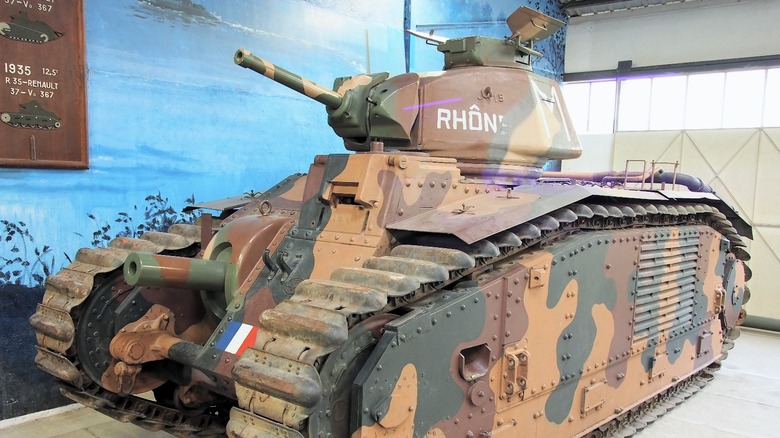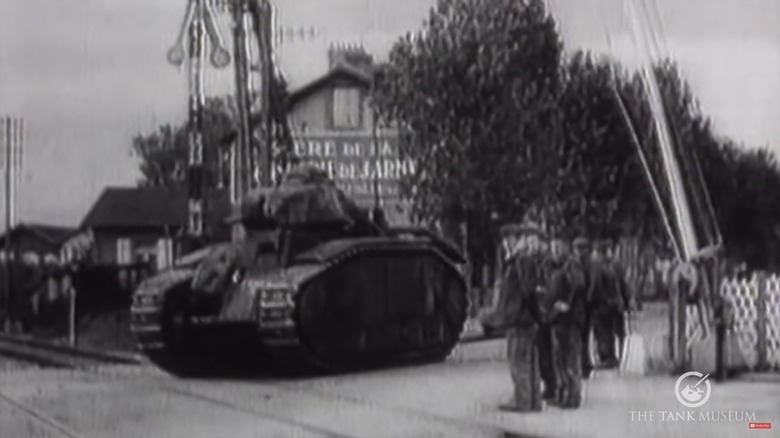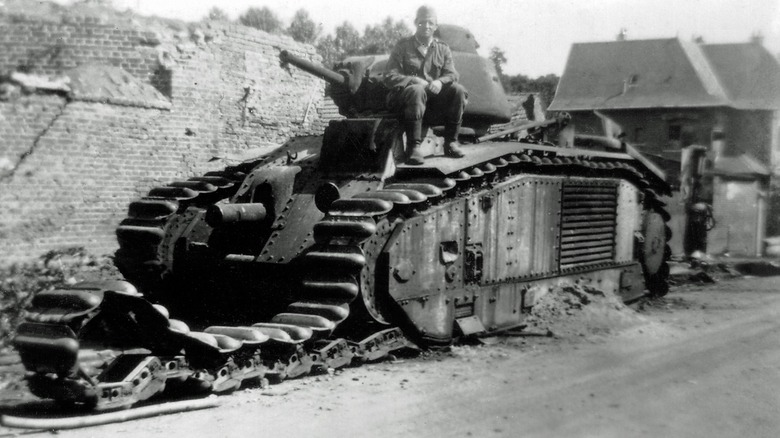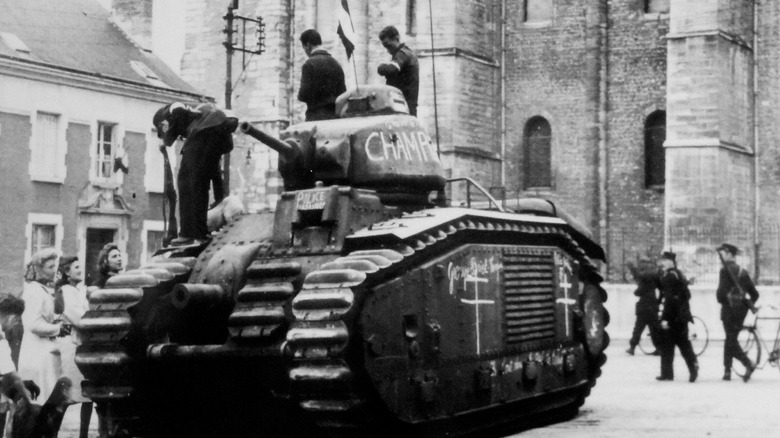Everything To Know About The 'Schneider Char B1' Heavy Infantry Tank
Heavy tanks are the largest cavalry meant to face off against other tanks. This means they have the thickest armor and biggest gun, trading off mobility for enhanced protection and firepower. Because of this, many countries and armed forces wanted to wield one on the battlefield as a superweapon.
That's why the German Tiger tank is widely known — and feared — among the Allies, because of its status as a heavy tank that will deflect the shots from most Allied tanks. Hitler also ordered heavier tanks like the Maus — called "Wunderwaffe," or "wonder weapons." The Soviets also had their own KV-1 heavy tank, which shocked the Germans in 1941, and encouraged them to develop heavier tanks than the Tiger.
However, these were not the first heavy tanks to face battle in 1939. At the outbreak of the war, neither the Germans, British, nor the Poles had any active heavy tanks. Instead, it was the French that fielded this monster of a weapon at the start of the war with the Char B1.
So, what is the Char B1 Heavy Infantry Tank, how did it affect the war for the French and the Germans, and what was its fate after the fall of France?
[Featured image by Alf van Beem via Wikimedia Commons| Cropped and scaled | Public Domain]
Older than the Tiger
The initial specifications for a battle tank came in 1921 — just three years after the end of the Great War, and six years after it was introduced. After several years and prototypes made by different French companies, the French government finally chose the Char B1 for production and ordered seven examples in 1934. This made the B1 eight years older than the German Tiger, which began production in 1942.
However, the Char B1 wasn't the final form of France's heavy tanks. As it was in development for so long, its armor was no longer sufficient for protection when it was ordered. So, by 1935, the French ordered the creation of the Char B1 bis, which featured additional armor and a more powerful turret gun.
Although the Char B1 bis was already a powerful tank, the French wanted to upgrade it to stay at the forefront of armor development. This was supposed to be the Char B1 ter, however, the fall of France in 1940 meant that research on this tank stopped as the Germans began taking over French war production.
How the Char B1 compared to German Panzers
To better understand why the Char B1 was a groundbreaking tank, let us look at its specifications, and how it compares to Germany's heaviest tank at the Fall of France in 1940 — the Panzer IV.
The Char B1 initially had 40 mm of frontal armor, but the B1 bis version upgraded this to 60 mm up front and 55 mm on the sides. It also had a 75 mm howitzer in the hull and a 47 mm turret gun, bringing its total weight to over 30 tons. All this mass is propelled by a 272 horsepower engine, allowing it to hit 28 kph (17 mph) on roads and 21 kph (13 mph) when traversing unpaved land.
On the other hand, the Panzer IV had 80 mm at the hull front — its sides and rear featured 30 mm armor or less, while its turret only had 50 mm or less of armor. It also only had one 7.5 cm gun, bringing its weight to about 24 tons. However, it's powered by a 296 horsepower engine, allowing it to hit a maximum of 42 kph (26 mph). Although the Panzer IV had superior frontal armor, it was at a disadvantage everywhere else. It could only face the Char B1 bis if it used its superior mobility to counter the B1's firepower.
However, the Char B1 and its upgraded bis variant did have one glaring weakness — the crew. These tanks required four crew members to operate: the driver, the loader for the 75 mm gun, the radio operator, and the commander. Furthermore, the tank commander also served as the loader and gunner for the 47 mm turret gun, overloading their workload. The loader and radio operator also had no seats, making those positions uncomfortable.
Desperate moves and heroic action
Despite its age in 1940, shortcomings in the crew department, and lack of support from the rest of the French forces, the Char B1 bis operated admirably during the German invasion of France. Marisa Belhote of the Tank Encyclopedia shares several stories of the Char B1's performance facing the onslaught.
A B1 bis named Sousse claims to have knocked out seven German vehicles — three with its turret gun and four with its 75 mm hull gun — while another damaged or destroyed another three before both tanks were knocked out.
Another B1 bis named "Eure" entered Stonne, France, and unexpectedly faced 13 Panzer IIIs and IVs at close range. It then used its dual guns to destroy two enemy tanks simultaneously before moving forward to decimate the rest of the armored column. It also destroyed two German anti-tank guns as it moved back toward French lines after clearing the town.
After the engagement, the tank crew counted 140 hits to Eure, which only dinged the armor. This showed the effectiveness of the tank's frontal armor, which was impervious to all the shots the Germans directed at the B1 bis. This heroic record proves that the B1 is France's best WWII tank.
Char B1s in Axis use
Although the B1 bis was effective against individual engagements, it was still insufficient to stem the German tide. Germany overcame France through its combined arms tactics and better armor doctrine. The latter eventually surrendered to the Axis Powers — a mere one and a half months after the start of the German offensive.
This meant the Germans and the Italians captured several B1s and B1 bis tanks. These tanks were then pressed into Axis service, with some serving as training vehicles, while others were re-equipped as 105 mm howitzer carriers called the Panzerkampfwagen B1-bis 740 (f). The B1 bis was developed into another variant — the Panzerkampfwagen Flamm(f) — which turned it into a flamethrower.
Some of these tanks were redeployed to the Eastern Front, facing battle in the Soviet Union. However, these were only in minimal numbers — about 12 tanks. The rest stayed in France, with one B1-equipped German unit, the Panzer-Abteilung 213, stationed on the Channel Islands until the German surrender.
Free French Char B1s and the end of the war
After Operation Overlord and the German retreat from France, Free French forces were able to recapture several examples of the Char B1s. Some French partisans were even able to capture B1 tanks from Germans and use them against enemy troops stationed in Paris as the Allied forces approached the city.
When the French Provisional Government was established after most German forces retreated from France, it also created a tank regiment armed with B1 bis tanks. This unit — the 13ème Régiment de Dragons — engaged pockets of German resistance on the French Atlantic coast, with none lost to action.
It eventually deployed to occupied Germany after the Fall of Berlin from May 1945 to April 1946. However, when the unit was recalled to France, it was soon dissolved. The Char B1 Heavy Infantry Tank was also struck from the list of French Army equipment alongside this event, officially ending its over-one-decade of service.
The French were knocked out early from World War II, meaning it couldn't develop its heavy tank industry the way the Soviets and Germans did. Nevertheless, they fielded a capable one right at the start of the war in the Char B1.
[Featured image by Musée de la Reddition via Wikimedia Commons| Cropped and scaled | CC BY-SA 4.0]



